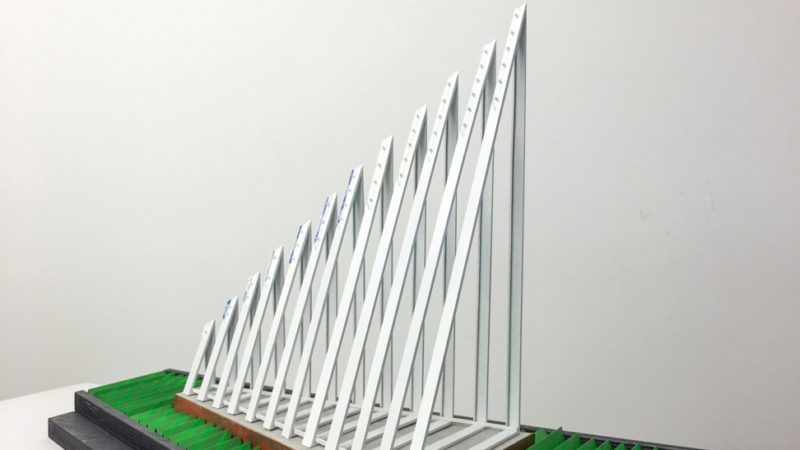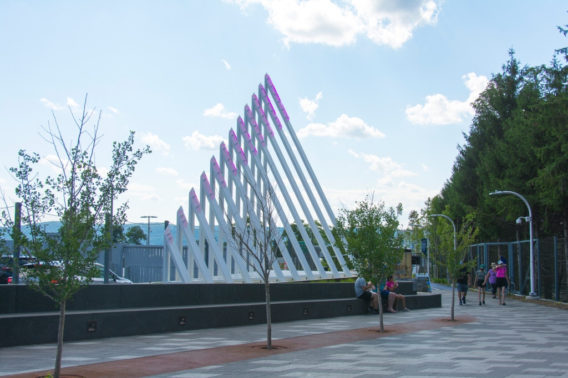
The artist Cheryl Wing-Zi Wong is interested in making public spaces come alive. She is known for sculptures that play with subtle refractions and permutations of light and shadow in their surrounding landscapes. Her work CURRENT is a sleek, triangular sculpture located along the Hudson River, designed to cast a shower of shifting hues and shadows that ebb and flow throughout the day like the waters nearby. The piece is built along the walkway for the Tappan Zee Bridge (now rebuilt and officially called the Governor Mario M. Cuomo Bridge), marking a point of flux by drawing out the nearby rhythms of pedestrian activity and the natural environs.
Wong’s work responds to the idea that so-called “public spaces” in cities are not always designed to be welcoming or community-minded. Drawing on influences from performance arts, her works explore how public art can function as a catalyst for activity, gathering, and reflection — and help awaken dormant parts of a site.
I spoke to Wong about how she created CURRENT, and how her design changed from idea to execution. In a way, her work continues to change even after installation, as it responds to small stimuli such as bikers passing or snow falling. Although her work is large-scale and permanent, Wong is also designing an experience that is ephemeral and ever-changing.
—Hua Xi for Guernica
Guernica: You create public pieces in which the concept is often influenced by the setting. What did you notice the first time you visited the site where CURRENT is now?
Cheryl Wing-Zi Wong: It’s sited on the eastern side of the new Tappan Zee Bridge, which spans the Hudson River between Rockland County and Westchester, New York. Here, you’re outside the city, with the river right there and glimmering speckles of light bouncing off of it. The lighting is always changing there. I live in New York City, and the change in light is less noticeable with so much built environment around…but on that site, there’s a lot more open sky, so you’re able to have a more direct relationship to what the sunlight is doing around you. Shadows also feel more deliberate, like this tree is casting this mark. There might only be four trees around, instead of a sea of bikes and buildings, so even shadows feel more intentional.
Guernica: Can you describe the piece?
Cheryl Wing-Zi Wong: CURRENT is an interactive public artwork. The piece consists of twelve steel arches, and there are glass fins at the tops of the arches and LED lights on the inside of each arch. It’s located alongside a bike and pedestrian pathway leading to the bridge.
Guernica: You’ve designed the piece to respond to the surrounding environment in various ways.
Wong: Yes, the final work emphasizes transformation, which the title also references, and creates a shared experience. During the daytime, sunlight reflects on the sculpture and through the dichroic glass fins, casting different colors at different times of day. Change also happens through the shadows created by the arches that dance on the plaza around it. When it’s dusk, embedded lights in the arches are illuminated and light animations play in response to movements on the pathways. If you walk past, it will trigger different light animations, like playing the keys of a piano. Throughout the seasons, throughout the times of day, it is always changing.
Guernica: So do you think of this piece as a clock?
Wong: Not quite. I think it can be a marker of time or change but the word “clock” feels so precise. A clock seems more fixed, and this piece responds to how the elements in the environment change. My other works, CONSTELLATION, MERIDIAN, and Pooltime, are clocks in the way that they respond specifically to the solstices — one of them is literally a sundial. But this artwork does not tell the time, or have the intention to tell you the time. It registers these marks of sun and shadow and time but it doesn’t follow chronological logic with a singular purpose.
Guernica: What role do you think public sculptures should play in the lives of the people who encounter them?
Wong: In my work, I think about everyday spaces and how we experience everyday life. Day to day, we go through this routine: we exit our homes, walk the same sidewalk. I started to observe myself and how I’m perceiving my environments, and started thinking more about how I might spark change. For me, my public sculptures are about creating an anchor moment to pause in. We often take everyday spaces for granted, but bringing in an artwork can disrupt that normal humdrum and create an opening for appreciation and/or activation.
Guernica: Does performance art influence how you think about your work?
Wong: Yeah, I’ve done a handful of performance works, often in collaboration with others, where we designed an experience and space that changed over time and elicited crowd responses. I’ve also done performances where I’m using installation or larger sculptures to draw in space on an architectural scale. I think this idea of performance is deeply foundational for my work. Putting things out there that don’t have a scripted outcome — that’s fascinating to me.
Guernica: Could you talk more about how performance influences the way you think about public spaces and their function?
Wong: Cities often have these giant and ever-present “public spaces” — and that’s “public spaces” in quotes because they’re not really designed for the public or the public isn’t allowed to use them. An example we see often are large concrete plazas without seating or shade elements. Bringing in an activation or a performance can be additive and help the space be used differently, as a public gathering space or a physical place to pause in. With CURRENT, I wanted to create something that’s always in motion and always dynamic, so that when you come back to it, it’s not a sculpture that’s just passive and sitting there, but instead it’s always active. It’s an architectural intervention that you perceive is always changing.
Guernica: How do you think about the balance between creating these permanent public works and incorporating this element of ephemeral change in them?
Wong: I often think about environmental change and time on two different scales. One is short-term, meaning by day and by night, like what shadows are being created throughout the day The other aspect of time scale is longer term, thinking more about differences occurring over the course of the year and seasonally, like how the artwork might change in the winter when the nights are longer and days are shorter, or in the summer when nights are really long and the sun is stretched out…and the different patterns in how people congregate in the warmer months.
Guernica: The material you use in part determines the types of structures you can build. How did you decide what materials to use for this piece and was it influenced by the environment?
Wong: Even before designing, I am thinking about materials. At the time I was thinking about steel, which is durable for permanent usage. Choosing to use steel was, in a way, setting up my own constraint, because now it’s a question of what I can do with it.
Guernica: Your final piece incorporates steel parts from the old bridge as well, right?
Wong: The New York State Thruway Authority set aside some steel for the artists to use. I thought, how could you be offered historic steel and not use steel that seems so important to this site, this space? The final piece integrates reclaimed steel from the old Tappan Zee Bridge as cladding for the concrete base of the sculpture. There are also mullions perched at the top of each arch that are made from this steel. Conceptually, this project is built from the bones of the old bridge.
Guernica: The other notable material this piece uses is dichroic glass. Could you explain what that is and how you brought it into the design?
Wong: The dichroic glass used here consists of two sheets of glass laminated together with a film in the middle that makes it iridescent. It’s always changing its appearance, shifting between pink and yellow and green and purple, depending on the angle you’re looking at it and the light moving through it, like a shiny piece of wrapping paper. It’s not only changing as light reflects through it, but it also changes as you move around the sculpture, so it adds an element of responsiveness.
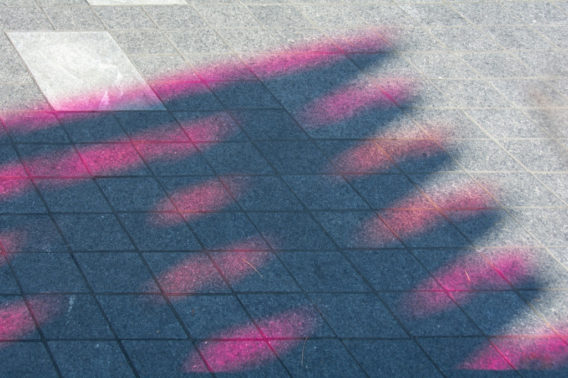
Guernica: How did you arrive at the final shape of a triangular structure?
Wong: When I started working on this piece, the area was a construction site and they were still building the bridge pathway, so you really had to imagine what it would look like. The site plan showed a granite two-tiered bench surrounding a triangular area. So from that 2D drawing, we had a triangular-shaped footprint, and that’s where I started.
Guernica: Were there other shapes that you played around with?
Wong: At first I tried out designs that weren’t as concentric, but they didn’t respond to the site as well, to the restrictive shape of the triangular boundary. I can’t exactly remember the other forms I played around with, but I do remember feeling like things looked like spiders and monsters.
Guernica: CURRENT, as well as works you’ve made in the past, is centered around these concentric geometries. Where does this form come from, for you?
Wong: I was thinking about the history of the bridge it is located next to. The Tappan Zee Bridge was the first major crossing over the Hudson, so when designing this work I was thinking about how to reference the actual currents of the river through creating a form that could resemble an echo and create currents of light. These concentric shapes are reminiscent of these river currents for me.
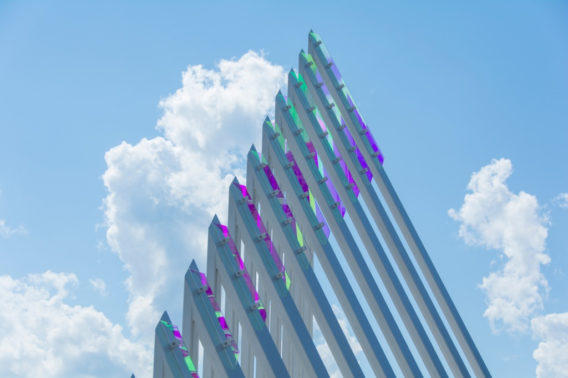
Guernica: Another dynamic component to the piece are the LEDs that play various light patterns. How did those fit into your overall vision for the piece?
Wong: The lights on the sides of the arches are responsive to motion in the surrounding environment. For me, the whole point of the motion-dependent light is to emphasize the experience of being here and now, and to share it with the other people in the space. There are about fifteen different light sequences and they play at random when a motion sensor is triggered.
Guernica: How do you design something in motion like that?
Wong: I worked with two lighting designers from ARUP, Xena Petkanas and Christoph Gisel, to design and program the light sequences. Initially, we had calls to talk about how you design a light sequence starting from more abstract ideas. We started with describing movements or things or feelings, talking about how it should “glimmer” and how to differentiate shimmer from glimmer, or if it should behave like glitter being tossed up in the air. We came up with these wacky names for different light animations.
Finally, after the sculpture was installed, we tested seeing these things live, which is very different from just looking at them on the computer in a digital mode. We then tweaked the speeds and intensities of the light animations.
Guernica: How did you decide what motion to have the lights respond to?
Wong: There is one motion sensor to the left of the artwork and one to the right of it. It’s sensitive enough to respond to bikers or people walking by. It’ll also respond if a branch blows by or a raccoon jumps in front of it, but it’s not as sensitive to pick up if a butterfly flies by. Actually, during the evening in its default state, without any motion triggers, the lights are on as if the sculpture is breathing or humming lightly.
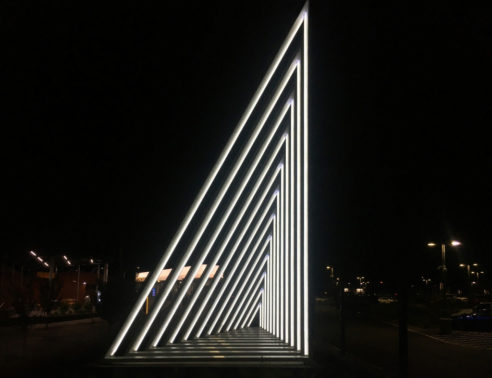
Guernica: Once the work was installed, did it continue to change for you?
Wong: CURRENT is always in flux, which is especially more evident during different seasons. It can be unpredictable, and during the daytime it can really change depending on where you’re standing and viewing the piece from. Throughout every bit of time, second to second, even if you step one foot to the left or to the right, there are nuances. You might see the glass as light pink, purple, or light green. You might see a reflection of your face peering back at you. It depends on how much cloud coverage there is and where the sun is.
The arches themselves are also casting different shadows, sometimes long, stretched out shadows and sometimes shorter, modest shadows, depending on the sun’s position. That’s something I hadn’t foreseen in my initial design renders, but in person, I saw that the arches were also casting shadows on each other and there were shadows moving across the interior of the arches, as if the artwork was folding in upon itself.
Guernica: Now that the piece has been installed for a while, have you gone back and visited? Have you observed it through different seasons?
Wong: I go back every now and then. I went back in December to take a look and it was really cool to see CURRENT covered in snow. When I was there, the sun wasn’t out, so the shadows weren’t as present.
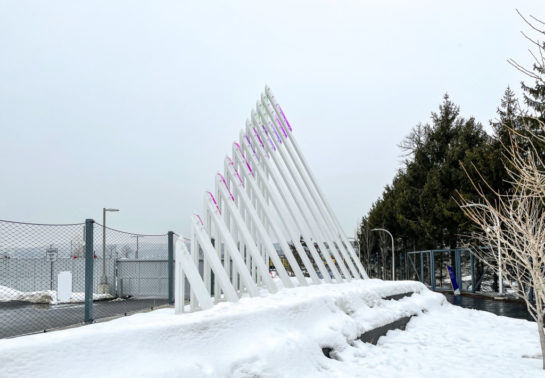
Looking at this piece is an incredibly active experience. You’re observing and feeling change over time, almost like passing through a dazzling shower of light, color, and shadow.
